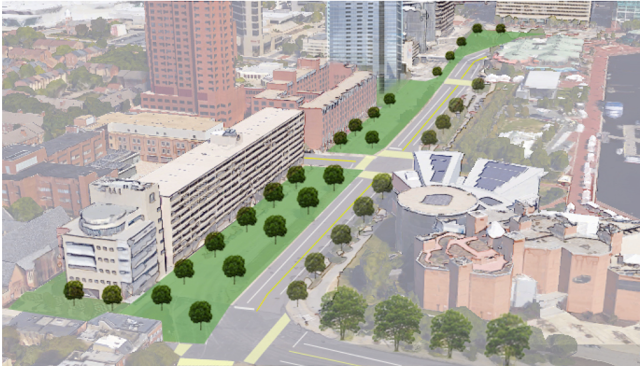America's mid-century highway boom marred many urban waterfronts. Technically, Baltimore doesn't have a grade-separated waterfront highway, but it's really no exception.
As Gerald Neily writes at Baltimore Innerspace, Light Street -- a 10-lane road on the edge of the city's Inner Harbor -- is a remnant of the Interstate era that functions like a surface highway, cutting off the waterfront from the rest of the city.
Neily says city officials should take that excess asphalt and put it to better use:
In many ways, the west shore's super-wide Light Street sets the tone for the entire Inner Harbor. Light Street sets the Inner Harbor apart so that it functions more like a separate tourist area and less like part of the city. Activity doesn't flow naturally from the rest of the city into the Inner Harbor. It requires a well-orchestrated visit.
Cities are built on interaction, tradition and ritual, whereas many if not most tourist areas must always keep reselling themselves based on what's trendy. This accounts for the perceived pressure to remake Rash Field into a "wow" attraction like Chicago's Millennium Park instead of just a place to hang out and play volleyball. Similarly, Harborplace failed as the local marketplace that James Rouse envisioned, and so instead has seen a procession of national merchants and tenants like "Ripley's Believe It or Not", and now a major gut-job to reinvent it once again. The city felt compelled to demolish McKeldin Fountain at great cost because it didn't appeal to someone's assessment of the lowest common denominator. It wasn't enough that many people loved it...
The design of Light Street isn't even a matter of choosing cars versus people. Both cars and people would be better off with a narrower Light Street, to reduce endless traffic weaving between lanes and the excessive clearance times to get through the giant intersections. Even the current adjacent bike lanes add to the Light Street pavement orgy...
Perhaps most importantly, this solution creates a large continuous new greenway along the west side of Light Street, northward from Key Highway. This greenway would be an ideal transition zone between the hub-bub of the Inner Harbor, the peacefulness of the surrounding neighborhoods and the purposefulness of downtown.
More recommended reading today: Twin City Sidewalks considers how horrific traffic collisions became so commonplace that they barely capture our attention. The FABB blog reports that police in a Virginia suburb are warning drivers not to yield to cyclists and pedestrians at a trail crossing. And Seattle Bike Blog reports that the city's new dockless bike-share service, financed and operated by a private start-up, is outperforming the old Pronto system that went belly-up, but questions remain about its long-term viability.





